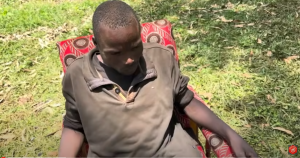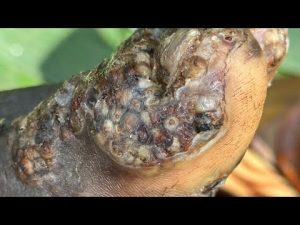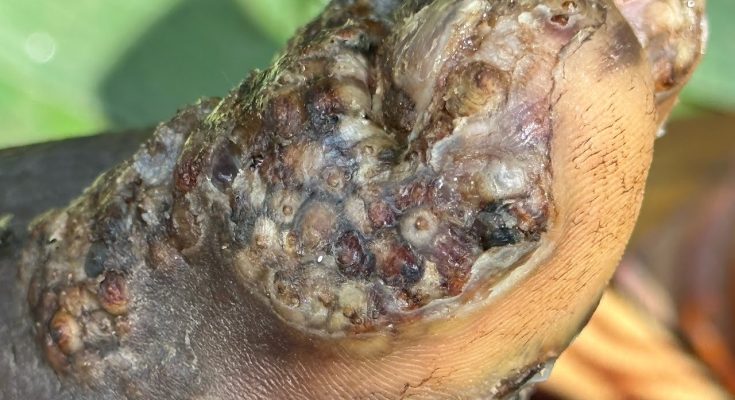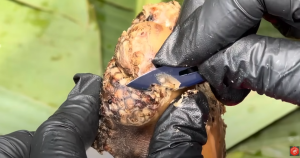JIGGER INFESTATIONS AMONG THE POOREST HUMANS: In large geographic
swaths on our planet, people are prey to the pestilence of Tungasiasis. This disease is caused
by the fleas known as Tunga Penetrans (aka jiggers, chigoe or sand fly), that burrow into
human flesh, lay eggs and then the larvae live on the blood of the host. Exposed skin on the bare
feet of people are the most vulnerable areas on the body, but infections are seen elsewhere such
as the hands knees and ankles. Prolonged infection results in gangrene and death. People who
lack basic protections such as footwear or flip flops, present easy targets for burrowing fleas.
Jiggers impact marginalized communities of low socio-economic status—mostly those who live
on less than $1 a day, in rural locales, with no access to medical care. Jigger infestations occur in
poor populations and can be as high as 60% with older adults, the disabled, and children 5-14
years being the most impacted. Tungiasis is often associated with social stigmatization.
The affliction is found primarily in sub-Saharan Africa (SSA). The jiggers have migrated there
from Central and South America.1 Despite the known epidemic of jiggers,
they are a largely unexplored affliction and very little governmental and
private sector partnerships exist to provide relief. Most of the treatment is
given free by non-profit groups. Removing jiggers outside medical facilities
is a primitive process—using small scalpels, and without pain medication.

When done locally by the victims themselves, thorns are often used. Cleaned jigger sites display
deep pits on the skin (Image above, pg. 1, bottom: Reddit.com).
Jigger eggs hatch into larvae in about 3-4 days and feed on organic
matter and blood. Tunga penetrans has two larval stages before
forming pupae. The pupae are in cocoons. The larval and pupal
stages take about 3-4 weeks to complete. Afterwards, adults hatch
from pupae and seek out a capilliaries for blood meals “ (Centers for
Disease Control). In short:
• Tungiasis is caused by female sand fleas, which burrow into the skin and lay eggs.
• Tungiasis can cause abscesses, secondary infections, gangrene and disfigurement.
• The disease is found in most tropical and subtropical areas of the world; the poorest
people carry the highest burden of the disease.
• Both animals and humans are susceptible.2
IMPACT: Repeated infections mutilate the feet, hands, elbows, knees, of the infected people.
Impaired physical fitness of adult household members has a deleterious effect on life quality of
households. Children
afflicted with
tungiasis show inability
to walk, attend school,
play, or perform other
life-necessity and lifequality needs. Bacterial
superinfection may cause
other life-threatening
complications such as
blood poisoning,
erythema, (reddening of
skin) edema (excess
fluid in skin),
desquamation.3
Pain and
itching are a constant presence. Itching induces scratching of the lesion facilitating the shedding
of eggs, and pupae. Abscesses, sometimes large, are frequent. (Images Left: jigger-ahadi.org).
2 Tungsaisis is the medical term for jigger disease.. 3 Diequalmification means rough scaly skin, often discolored—see picture above right

TREATMENT: In infected regions the sand fleas are often removed horrifically and
imperfectly by the sufferers themselves, using thorns, safety pins, hair pins or other sharp
objects at hand. With these, the
victims try to poke out the sand
fleas, their egg sacs, and larvae that
live under the skin.
Charitable organizations do come on
site and partially fill the gap between
the public and private sectors.
However, their resources are limited.
They use small scalpels which are
slightly more effective than the home-made tools used by the affected
people. Nevertheless, scalpels, pose their own hazards that arise from
unskilled or accidental wounding.
Removing the burrowed parasites can cause local inflammation if the parasite ruptures and in
doing so, introduces pathogenic bacteria into the wound–leading to further infection of the
lesion. Furthermore, using the same implements on several people one after another, risks the
spread of the hepatitis B virus (HBV), hepatitis C virus (HCV) or HIV. After removal of the
sand fleas and their habitats, the wound needs aftercare—such necessary things, as sterile
dressings, tetanus vaccination, pain relievers, etc., all of which are not available to the suffering
poor.


THE DYNAMIC NATURE OF POVERTY & HUMAN HEALTH: The UN has long
maintained that poverty is both a cause and a consequence of poor health. Poverty increases the
chances of poor health and poor health, and bad hygiene, in turn, ensnare destitute populations to
remain in destitution. Infectious and neglected tropical diseases kill and weaken millions of the
poorest and most vulnerable people each year.
The UN SDG Report (2018) notes that: “Transitioning towards more sustainable and resilient
societies also requires an integrated approach that recognizes that these challenges—and their
solutions….” The UN has warned world governments that they must reflect on how societies
can be made more resilient while confronting challenges such as tungasiasis. The window of
opportunity is closing in fast. The agency states that: “A good place to start is by establishing
robust water and sanitation infrastructure, ensuring access to clean and affordable energy,
building safe and ecologically friendly cities, protecting ecosystems, and instituting sustainable
consumption and production patterns.” (UN SDG Report, 2018.)
DEONTOLOGICAL ASPECTS FOR BIG PHARMA CONSIDERATION: It has been
often observed in scholarly writing, as well as in popular writing, that global “Big Pharma’s”
social responsibilities to the developing world are insufficiently addressed, and that they must
exercise these responsibilities by investing in research and development related to diseases that
affect developing nations, offering discounts on drug prices, and initiating drug giveaways.
Richard Saynor, Vice President, GlaxoSmithKline (2018) observed: “On the part of
pharmaceutical companies, we have a responsibility to help people gain access to high-quality
healthcare and the medicines that they need, no matter where they live in the world or how much
they can afford.” Other pharmaceutical companies have expressed similar sentiments—but the
hidden epidemics among the global poor in less developed nations still remains hidden.
SELECTED RESOURCES:
1. “WHA66.12 Neglected tropical diseases” (2013, WHA66.12, CC BY-NC-SA 3.0 IGO)
Sixth World Health Assembly, WHO
Neglected tropical diseases (NTDs) include several parasitic, viral, and bacterial diseases that
cause substantial illness for more than one billion people globally. Affecting the world’s poorest
people, NTDs impair physical and cognitive development, contribute to mother and child illness
and death, make it difficult to farm or earn a living, and limit productivity in the workplace. As a
result, NTDs trap the poor in a cycle of poverty and disease.





